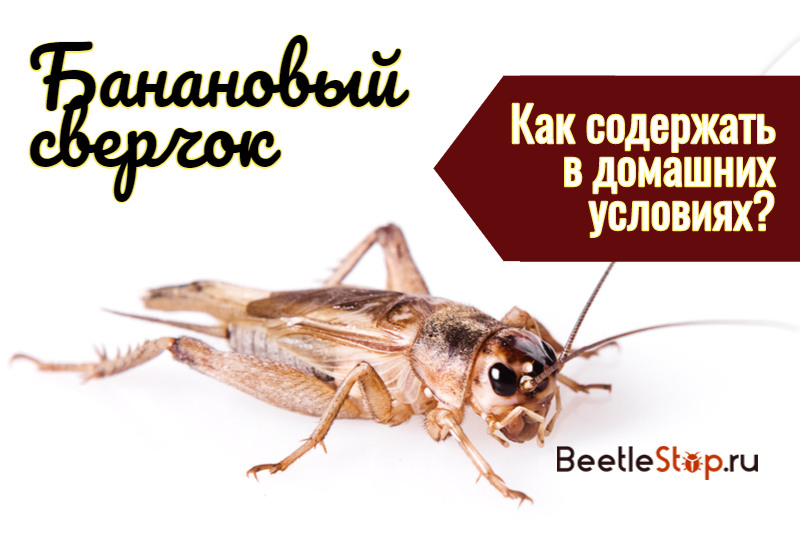Banana cricket: features of keeping and breeding animal feed
Banana crickets belong to the order of Orthoptera. Their closest relatives are grasshoppers and locusts. In nature, the insect is not known, although it is often confused with Jamaican field crickets. The artificially bred species has become popular as a feed insect. In its nutritional value, it is significantly superior to other species. Insects are easy to maintain and picky in food.

View description
Banana cricket (Gryllusiocorojo) is a representative of the order Orthoptera, a family of real crickets. Ecuador is supposedly considered the country of origin. From South America, the insect eggs got to the Berlin Zoo, and from it got to Russia. A new species of crickets was described in 2012 and received the scientific name Gryllus iocorojo.
The body length of the insect is 18-25 mm, the shape is elongated. The head is large, the mouth organs are gnawing. Antennae long, bristle-shaped. Elytra short, wings well developed. Body color is red-brown. On the head there are several bright longitudinal stripes. The hind legs are elongated, the hips are thickened - such a structure of the limbs helps to jump over a considerable distance. Life expectancy of adults is 1-1.5 months.
Interesting fact. A notable feature of banana crickets is the ability to make sounds. Singing of the insect occurs when rubbing the elytra against each other. You should find out about this feature before you start breeding.
What capacity to choose for content
Containers for breeding can be from various materials:
- plastic;
- glass;
- chipboards.
The capacity should have parameters 60x40x40cm. Insectarium sizes are adjusted depending on the number of residents. A plastic or glass container is the best option. They have smooth walls that make crickets difficult to crawl up. Transparent material allows you to watch pets. The surface of wooden crates is more difficult to care for. The container is covered with a lid. It is important to provide ventilation, for this the container must be with openings.
Tip. As a cover, you can use a frame with a fine mesh.
Crickets prefer a secretive lifestyle, so they need shelter. The most common option is cardboard egg trays. Several trays are installed horizontally on top of each other, some are placed vertically.
Microclimate
The heat-loving insect needs to create comfortable conditions with a temperature of at least 25-26 °. You can warm the insectarium with 25-40 watts lamps. They will help ensure the required temperature and daylight hours of at least 16 hours. Recommended humidity is 40-50%. The substrate for eggs is moistened additionally.
How to feed insects
Insects get slices of vegetables (cucumbers, carrots, lettuce), fruits (apples, oranges, pears), crackers, oatmeal. Some breeders feed their dogs dry food for dogs or cats. In the warm season, the diet is supplemented with fresh herbs - dandelions, burdocks and other plants. For the full development of adults and eggs, insects need protein. They can get it by eating corpses or doing cannibalism.To prevent such a situation, dry hamarous is included in the food. These are crustaceans with a high protein content (56%).
A banana cricket does not fit an ordinary drinker. They can drown even in a small amount of water. In a saucer with a liquid, a fabric is necessarily laid. Insects drink from her. With a sufficient amount of wet food, the drinker can not be used.
Insectarian Care
Breeding banana crickets requires special insect care. The owner will need several containers for moving pets. The optimal amount is 3-4. This is due to the need to maintain cleanliness in insectariums. Crickets are caught with tweezers and shaking in a small container, then transplanted into a new cage. Cleaning is carried out once a week. It is necessary to replace the substrate, remove the old feed, wash the container. Dirt and excrement inhibit the development of crickets, young growth is slowly growing and gaining weight. If preventive measures are not followed, ticks will start in the substrate. Because of them, the colony quickly perishes.
Optimal conditions:
- temperature - 28-33 °;
- a lot of juicy fruits;
- the presence of protein foods;
- regular litter change.
Attention. Do not allow a significant increase in the number of insects in the cage. This will lead to cannibalism and the delayed development of young animals.
Propagation Features
In insects, sex differences are expressed, females are longer than males due to the ovipositor at the end of the abdomen. Outwardly, it looks like a soft needle 12-16 mm long. Reproduction does not occur in a certain period, but all year round. The optimal number of individuals for breeding is one male per four females. Crickets are insects with incomplete transformation; they go through the following stages: egg, larva, and imago. After fertilization, the female lays small (2-2.5 mm) yellowish eggs in cracks or substrate. The number of eggs in the clutch depends on the temperature in the cage. In a hot microclimate, the female is more fertile; she can lay up to 700 eggs. The place of masonry is a transparent box filled with moist vermiculite or coconut fiber.
Tip. Cover the egg containers with a wire mesh to prevent adults from eating the masonry.
The embryo's ripening time depends on temperature, with a temperature of 28 ° it will take 1-3 weeks, under cooler conditions - up to 12 weeks. A transparent larva passes 10-12 molts until it turns into an adult.
Banana cricket is a favorite delicacy of many exotic animals. Their breeding at home is not a problem. Insects breed rapidly, are not picky in food.


 (votes: 9, average rating: 4,56 out of 5)
(votes: 9, average rating: 4,56 out of 5)